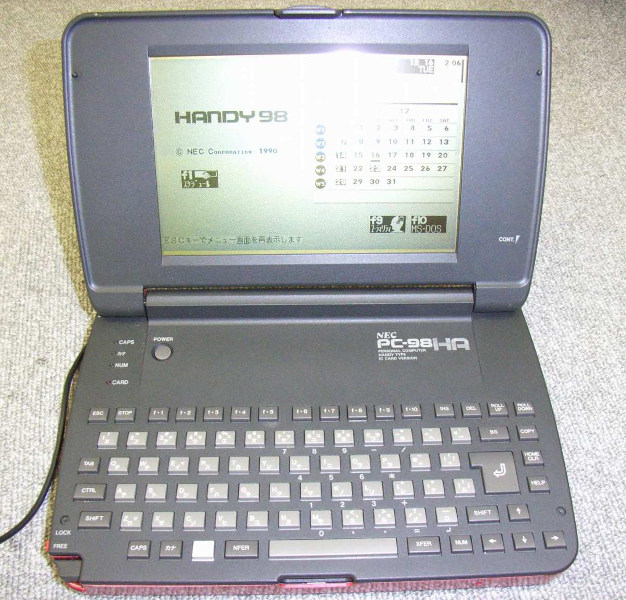DOS Palmtop: NEC PC-98HA Details and specs
NEC PC-98HA (Handy98)

About this machine:
It's hard to find some point to start with this oddball. Released in 1990 it was among the first palmtops and actually the first DOS based palmtop made (exclusively) for a Japanese audience. The story is mostly about failure which starts with it's name. Most of you will not understand the meaning of "98" (No it has nothing to do with Windows 98"!) unless you are really much into Japanese computers. "98" - or as the Japanese say "Kyu hachi" - was the common term to refer to the NEC 9800 series of computers which was in japan THE de facto standard for computers, similar to what "IBM PC compatible" was to the rest of the western world. So there were countless "PC98" programs, games and so on - most professional or free software was written based on the PC98 standard. Until 1990 when IBM released "DOS/V" (Not DOS 5 - read it as "DOS/ VGA") all western IBM compatible computers were regarded an "obscurity" since they wouldn't display Japanese characters properly with their low resolution displays. So you imagine how big the disappointment was when NEC released this "Handy 98" because in fact it was NOT the beloved "PC-98" compatible but simply an x86 with DOS 3.1. Which would have been good for us western X86 fanboys (like me) IF it would have been more of an IBM PC compatible. Most Japanese felt scammed since PC-98 programs would NOT run on this machine. As a DOS machine the lack of CGA (Or EGA) compatibility makes it quite useless. So effectively a user shelling out a lot of money for this could neither use one of the thousands of PC-98 programs nor DOS programs. And without the expensive floppy docking station data exchange with another computer was very difficult and DOS files and floppy were generally incompatible with the common PC-98 standards. Other flaws were the terrible keyboard, the proprietary mini ports, the weight (a whooping 1.1 Kg) and the rather poor display (no grey scales). There was a docking station available which only featured a floppy disk drive. There was an obscure external pack for AA-Batteries available, so you could use a bunch of AA-Batteries to boost the actual battery life or recharge the internal one. This was a big disappointment for Japanese users back in the day and it could be a big disappointment for you, too - if you find one today. They were released in different colors - White, black and red.
Specs:
CPU: NEC V50 @ 10 MHz
Graphics: Monochrome - Custom display mode, not compatible with anything but text mode
Display: 640 x 400 monochrome LCD , No grey scales
Memory (RAM): 2 MB (640KB, rest as RAM drive)
ROM (Software): 2 MB (Estimation)
I/O ports: Proprietary Serial, Proprietary Parallel, 1 x PCMCIA 1.0 Type I slot, Docking station port
Sound: PC Speaker - Piezo
Operating System: MS-DOS 3.1J (Japanese)
Software: Japanese MS-Works, N88 BASIC and some proprietary alarm/schedule appz
Size: Length 14.8 cm, Width 23.4 cm, Height 3.60 cm
Powered by: proprietary rechargable battery pack
Weight: 1100 gram including battery pack
Special features: none
Released: October 1990
Originally retailed for:: 198,000 Yen
Clone of: Not a clone, very unique
Similar models: Oasys Pocket 3
Pros:
- Uh...Rare?
Cons:
- One of the worst keyboards
- Terrible screen without grey scale
- Only PCMCIA 1.0, so besides SRAM cards barely anything you can use it for.
- Not really IBM PC compatible although some text mode appz work fine
Collector Value:
8 of 10
Usage Value:
2 of 10
Verdict:
I really wanted to find some positive points about it for the list, but i couldn't really think of any. Besides being kinda collectible it is not very usable or attractive for most users. I gave it 2 points because of the built-in MS-WORKS. Add a few points to the usage value if you speak Japanese and never use anything besides MS-WORKS or a scheduler. Collector value is only if you count this as a DOS palmtop - which might be a stretch depending on the point of view.
Back to the Palmtop PC index
